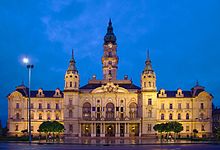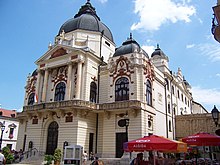
Transdanubia (Dunántúl), too West Hungary or Pannonia called, includes the part Hungary west of the Danube.
Regions
The following counties (administrative regions) form the Trans-Danubian part of Hungary:
Western Transdanubia (Nyugat-Dunántúl)
- Győr-Moson-Sopron, Capital Gyor
- Vas, Capital Szombathely
- Zala, Capital Zalaegerszeg
Central Transdanubia (Közép-Dunántúl)
- Fejér, Capital Székesfehérvár
- Komárom-Esztergom, Capital Tatabánya
- Veszprém, Capital Veszprém
Southern Transdanubia (Dél-Dunántúl)
The Balaton (Lake Balaton) is located in Transdanubia and, due to its great tourist importance, represents a separate, cross-county travel region.
places



- Gyor (Raab) - largest city in western Hungary, thanks to its convenient location and the Audi factory, one of the country's most economically strong cities, baroque architecture well worth seeing.
- Pécs (Fünfkirchen) - strongly multicultural (including the center of the Hungarian Germans, Roma and Croats), university town and bishopric, art nouveau buildings worth seeing
- Székesfehérvár (Stuhlweissenburg) - in the Middle Ages the coronation city of the Hungarian kings, hence called the “city of kings”, with a historic old town.
- Esztergom (Gran) - the city on the Danube with the largest basilica in Hungary (one of the largest church buildings in Europe) and a well-preserved medieval castle
- Sopron (Ödenburg) - in the far north-west of Hungary, borders on three sides with Austria, well-preserved old town with medieval and baroque buildings
- Sumeg - the old castle, lying at a height of 270 m.
- Szombathely (Steinamanger) - with origins from Roman times.
- Tatabánya - the Turul viewpoint and panoramic view.
- Veszprém - Sights in and outside of the castle district.
- Zalaegerszeg
- Szekszárd - The city on the Danube is famous for viticulture
Other goals
- cross-border Raab-Őrség-Goricko Nature Park at the border triangle with Austria and Slovenia
- Cultural landscape around the Lake Neusiedl - UNESCO world heritage
background
language
getting there
In Sármellék near Hévíz on the west bank of Lake Balaton there is an international airport which is mainly accessible by direct charter flights from German-speaking countries, mainly in the summer season. In addition, there is an arrival via the airports surrounding the region Budapest, Vienna, Bratislava, Zagreb or Graz into consideration.
Rail connections are well developed in the western part of Hungary. All major cities can be reached by train, although the journey often leads via Budapest or Vienna.
mobility
Tourist Attractions


- Fertőd - Small town with Eszterháza Palace, the "Hungarian Versailles"
- Keszthely - and the wonderful baroque Festetics palace.
- Lébény - the huge Romanesque cathedral from the 12th century is one of the national symbols of Hungary.
- Pannonhalma - the Benedictine abbey from the 11th century is a Unesco world heritage site.
- Dunaújváros - The socialist planned city around a steelworks offers interesting insights into urban planning and architecture of the late 1940s.
activities
There are numerous thermal baths in the region (e.g. Sárvár, Hévíz, Bük) and the Balaton and Lake Velence are ideal for bathing holidays and all kinds of water sports in summer.
kitchen
The Hungarian standard kitchen dominates, whereby you can also get Austrian dishes in the areas close to the Austrian border. There is also a wide range of international restaurants in the big cities. Wine-growing areas can be found specifically in the west of the region and in Sopron there is a large brewery (Soproni Aszók).
nightlife
security
The security situation does not differ from that in the rest of Hungary or in neighboring eastern Austria.
climate
The climate is Pannonian, which means it is slightly continental with hot, dry summers and cold, dry winters. Most of the rainfall occurs in autumn and spring. There is little snow in winter, and heat thunderstorms often occur in midsummer.
